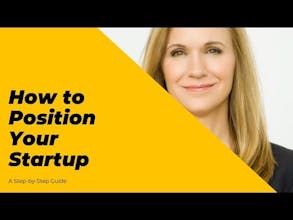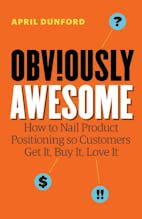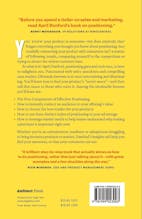
Obviously Awesome
How to nail product positioning
1 follower
How to nail product positioning
1 follower
You know your product is awesome—but does anybody else? Forget everything you thought you knew about positioning.



April Dunford
Maker
Hey, it's April here - I'm the author. Thanks Nichole! I wanted to give you all a little background on how this book came about - it was a very long road.
My first job out of engineering school was a database startup. We repositioned a product from a lightweight personal database to an embeddable database for mobile devices. Our growth exploded and we were acquired. My eyes were opened to the power of positioning.
After that, I spent a couple of years at the big co. then moved to the next startup. We repositioned that product too - from an enterprise CRM to a CRM for investment banks. Big growth followed again and we were acquired for $1.3B.
Across my career, I was an exec at 7 startups. 6 of those were acquired which landed me at 5 big companies. All in, I launched 16 products into market. We repositioned every single one at some point.
Because I hadn’t studied marketing at school, early in my career I read stacks of marketing books and took dozens of courses. I learned a lot but one thing really bugged me - why didn’t we learn how to do positioning?
It's the starting point for almost everything we do in marketing + sales (it defines our competition, differentiated value, target segments) - but there didn’t seem to be a process for actually DOING it. At least not one that made sense. I was taught the Positioning Statement - a laughably vague fill-in-the-blanks exercise that relies on voodoo+intuition to choose what market you should be positioned in. This exercise offended my engineering sensibilities!
Every product can be positioned in multiple different markets - so how do we choose the best one? Surely we don’t just write down whatever pops into our heads!!?
I figured positioning could be broken into parts: competitive alternatives, unique capabilities, differentiated value, target customers, and market category. Essentially the “blanks” of a positioning statement. Get the best answer for each and voila, you've got great positioning.
However, the deeper you go the more you realize that the components have a relationship with each other. Value depends on your capabilities, which are only differentiated when compared to alternatives. Our target segments are defined by who cares most about the value we deliver, etc. If you want to get to positioning that’s really differentiated, you have to work through the pieces in the right order.
So I developed a process for doing positioning - first for my own use as an exec and later I taught it to startups in one-on-one workshops and group classes at accelerators. The process became more refined (and battle-tested by skeptical startup founders).
Today I'm a consultant (for tech companies looking for positioning help). But I can't help everyone that calls me. My calendar gets full and some companies are too far away. So I decided to write the process down so anyone could learn it.
The result is this book. I really hope folks find it useful.
Report
Els Aerts
A lot of business books are 20% meat and 80% fat.
Not so with April’s book ‘Obviously Awesome’.
Every page, every sentence, every word holds value.
This woman has been in the trenches. She knows what she’s talking about.
When it comes to positioning, she has no equal.
This book is gold.
Report
April Dunford
Maker
@els_aerts I really appreciate that Els!
Report
Nichole Elizabeth DeMerè (Eithiriel)
Hunter
Successfully connecting your product with consumers isn’t a matter of following trends, comparing yourself to the competition or trying to attract the widest customer base.
So what is it? April Dunford, positioning guru and tech exec, will enlighten you.
Her book, Obviously Awesome, shows you how to find your product’s “secret sauce”—and then sell that sauce to those who crave it. Having spent years as a startup executive (with 16 product launches under her belt) and a consultant (who’s worked on dozens more), Dunford speaks with authority about breaking through the noise of a crowded market.
Punctuated with witty anecdotes and compelling case studies, Dunford’s book is at once entertaining and illuminating. Among the invaluable lessons you’ll learn are:
- The Five Components of Effective Positioning
- How to instantly connect an audience to your offering’s value
- How to choose the best market for your products
- How to use three distinct styles of positioning to your advantage
- How to leverage market trends to help buyers understand why making a purchase is important right now
Whether you’re an entrepreneur, marketer or salesperson struggling to bring inventive products to market, Dunford’s insights will help you find your awesome, so that your customers can too.
Report





